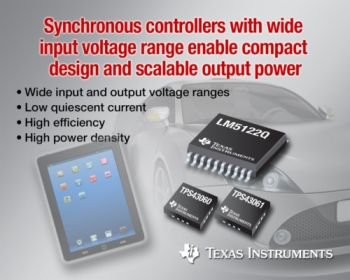Texas Instruments Incorporated (TI) today introduced three wide-input voltage synchronous boost controllers with high efficiency and high power density. The LM5122Q multi-phase boost controller features the industry's widest input and output voltage range. The low quiescent-current TPS43060 and TPS43061 boost controllers feature 1-MHz operation and a small QFN package.
 LM5122Q multi-phase boost controller (PRNewsFoto/Texas Instruments Incorporated)
LM5122Q multi-phase boost controller (PRNewsFoto/Texas Instruments Incorporated)
TI's new synchronous boost controllers increase efficiency by up to 10-percent over non-synchronous boost controllers by replacing the freewheeling diode with a synchronous switch. Lossless inductor DCR current sensing further improves efficiency and reduces heat dissipation to save board space and lower bill of materials cost. Each boost controller features thermal shutdown, frequency synchronization, hiccup-mode current limit and an adjustable line under-voltage lockout.
The LM5122Q is an AEC-Q100-qualified synchronous boost controller with a 3-V to 65-V input and up to 100-V output voltage range. The controller can be configured easily for interleaved multi-phase operation, which is required for high power applications like start-stop voltage stabilizers and high power audio amplifiers. A powerful 3-A gate drive circuit supports voltages up to 16-V, enabling flexibility to tune the step-up DC/DC for efficiency and size.
TI will demonstrate the LM5122Q in its booth #109 at the Applied Power Electronics Conference and Expo (APEC) in Long Beach, Calif., Mar. 18-20.
The TPS43060 and TPS43061 are low quiescent-current synchronous boost controllers with an input voltage range from 4.5 V to 38 V and an output voltage range of up to 60 V. The TPS43060 provides a 7.5-V gate drive, which drives a broad range of low-cost MOSFETs. The TPS43061 provides a 5.5-V gate drive, optimized for low Qg MOSFETs, such as TI's CSD86330Q3D synchronous buck NexFET™ Power Block, which saves up to 50-mm2 of board area. Applications include tablet and notebook USB charging adapters, and industrial test and measurement equipment.
The synchronous boost controllers join TI's family of step-up power products that include the TPS55340, a 40-V boost converter with an integrated 60-milliohm MOSFET. For more information on all of TI's DC/DC switching regulators, visit www.ti.com/regulators-pr.
Key features and benefits of the LM5122Q boost controllers:
- 100-V output range and 65-V input range simplifies high-voltage design.
- High power density is easily achieved with interleaved multi-phase operation.
- Bypass feature enables pass-through of input to output when boost functionality is not required.
- User-selectable diode emulation enables improved efficiency at light load conditions.
Key features and benefits of the TPS43060 and TPS43061 boost controllers:
- 500-uA quiescent current supports battery-powered applications.
- Up to 1-MHz operation allows small inductor and ceramic capacitors, which reduces overall solution size.
- -40 degrees C to 150 degrees C operating junction temperature for robust performance in hotter environments.
Availability, packaging and pricing
The TPS43060 and TPS43061 are available in volume now from TI and its authorized distributors. Offered in a 16-pin QFN PowerPad™ package that measures 3 mm by 3 mm by 0.75 mm, the TPS43060 and TPS43061 are priced at $1.40 in 1,000-unit quantities.
Samples and production quantities of the LM5122Q are expected to be available in the second quarter. Offered in a 20-pin TSSOP package that measures 6.5-mm by 4.4-mm by 0.9-mm, the LM5122Q is priced at US$2.10 in 1,000-unit quantities.
Find out more about TI's power products:
- Order samples and an evaluation module of the boost controllers:
- Get more information on all of TI's power products: www.ti.com/power-pr.
- Design a complete power management system online with TI's WEBENCH® Power Designer: www.ti.com/webenchpwr-pr.
- Check out "Jeff does APEC" live on the Power House blog to keep up with trends and topics from the showroom floor.
- Ask questions and share knowledge in the power forum in the TI E2E™ Community: www.ti.com/powerforum-pr.
- Download power reference designs from TI's PowerLab™ Reference Design Library: www.ti.com/powerlab-pr.